Marc Tyler Nobleman's Blog, page 81
May 25, 2014
Hands Across America - 28th anniversary
On 5/25/86, I supplied two of the hands in Hands Across America.
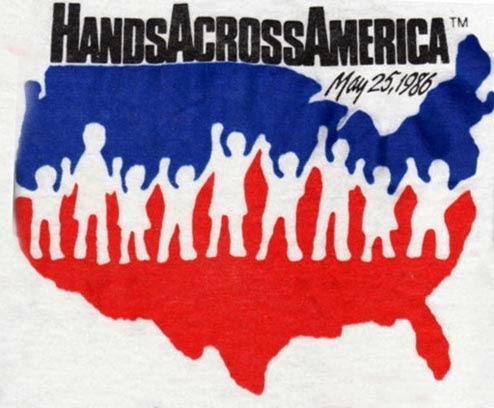
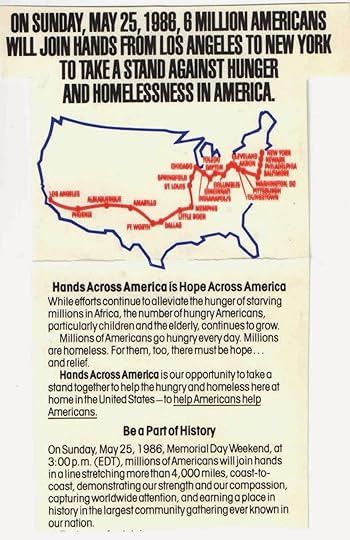
Somehow I managed to drag my dad and sister there, too; we must have taken the train from New Haven, CT, to New York City. I was in middle school yet I remember almost nothing about this momentous event. Even the photos are not triggers.

 Product placement.
Product placement.

 The actual holding of the hands.
The actual holding of the hands.
 My sister and father.
My sister and father.
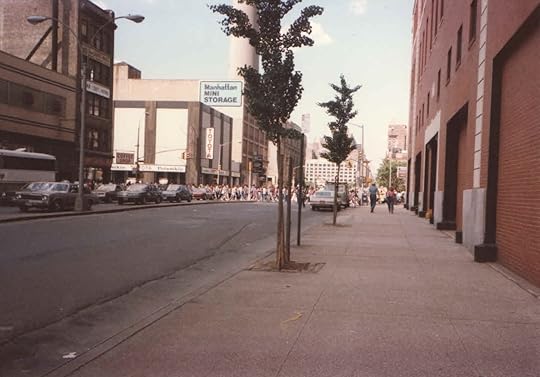 Throng of people crossing street in distance, with rest of area deserted.
Throng of people crossing street in distance, with rest of area deserted.


Somehow I managed to drag my dad and sister there, too; we must have taken the train from New Haven, CT, to New York City. I was in middle school yet I remember almost nothing about this momentous event. Even the photos are not triggers.

 Product placement.
Product placement.
 The actual holding of the hands.
The actual holding of the hands. My sister and father.
My sister and father. Throng of people crossing street in distance, with rest of area deserted.
Throng of people crossing street in distance, with rest of area deserted.
Published on May 25, 2014 04:00
May 22, 2014
What is original about Superman and Batman
Non-superhero fans might not see much difference between Superman and Spider-Man and Everyotherman.
They probably don’t know that Superman is generally considered the world’s first superhero and that Batman followed less than a year after.

Why did Superman and Batman endure to this day but no action figures or film franchises came calling for, say, the Enchanted Dagger and Micro-Face?

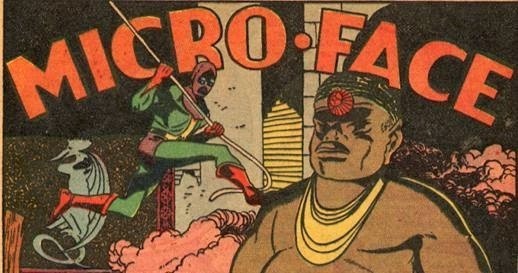
To be sure, not every original character has a long life, and not every character who has a long life has it because of originality…but I do think Superman and Batman’s originality contributed to their success.
Multiple external factors contributed to the longevity of the Man of Steel and the Dark Knight, but here are conceptual reasons.
What was original about Superman:
first comic book character with powers, costume, and secret identity (all three elements existed before, but not in a single character)unfamiliar figure in familiar setting (prior to Superman, science fiction commonly portrayed humans visiting other worlds—we were the strangers in a strange land)civilian, not hero, was the fabricated identitya superhuman who was benevolent, not alienated or power-mad
What was original about Batman:
Batman was not the first do-gooder without powers. He was also not the first hero who was orphaned as child, not the first to wear a costume, not the first to have a secret identity, and not even the first with blanks for eyes.
Yet he was the first hero in comic books whose orphaning inspired his heroism—i.e. the first with a psychological reason to wage war on crime.
Of pre-Batman costumed heroes the Scarlet Pimpernel, Tarzan, Zorro, Gladiator, the Green Hornet, Doc Savage, the Phantom, the Shadow, Buck Rogers, Flash Gordon, and the Spider, none appear to be driven by vengeance or grief rooted in childhood; the Lone Ranger’s brother was killed, but both were already adult.
Also, Batman was a hero who looked like a villain and a vigilante who was also a detective.
Both Superman and Batman synthesized qualities from previous figures of literature, film, and myth to create something that felt utterly new.
They probably don’t know that Superman is generally considered the world’s first superhero and that Batman followed less than a year after.

Why did Superman and Batman endure to this day but no action figures or film franchises came calling for, say, the Enchanted Dagger and Micro-Face?


To be sure, not every original character has a long life, and not every character who has a long life has it because of originality…but I do think Superman and Batman’s originality contributed to their success.
Multiple external factors contributed to the longevity of the Man of Steel and the Dark Knight, but here are conceptual reasons.
What was original about Superman:
first comic book character with powers, costume, and secret identity (all three elements existed before, but not in a single character)unfamiliar figure in familiar setting (prior to Superman, science fiction commonly portrayed humans visiting other worlds—we were the strangers in a strange land)civilian, not hero, was the fabricated identitya superhuman who was benevolent, not alienated or power-mad
What was original about Batman:
Batman was not the first do-gooder without powers. He was also not the first hero who was orphaned as child, not the first to wear a costume, not the first to have a secret identity, and not even the first with blanks for eyes.
Yet he was the first hero in comic books whose orphaning inspired his heroism—i.e. the first with a psychological reason to wage war on crime.
Of pre-Batman costumed heroes the Scarlet Pimpernel, Tarzan, Zorro, Gladiator, the Green Hornet, Doc Savage, the Phantom, the Shadow, Buck Rogers, Flash Gordon, and the Spider, none appear to be driven by vengeance or grief rooted in childhood; the Lone Ranger’s brother was killed, but both were already adult.
Also, Batman was a hero who looked like a villain and a vigilante who was also a detective.
Both Superman and Batman synthesized qualities from previous figures of literature, film, and myth to create something that felt utterly new.
Published on May 22, 2014 04:00
May 20, 2014
Authors to Oklahoma after the tornado
A year ago today, as no one needs reminding, a tornado struck Moore, OK, leveling two elementary schools (Briarwood and Plaza Towers) among, of course, many other buildings.
When I saw this heartbreaking graphic, I felt I had to try to do more than donate to the Red Cross.
 Plaza Towers Elementary School, before and after
Plaza Towers Elementary School, before and after
I wanted to replicate the moving kidlit author variety show we did for the students of Sandy Hook Elementary School in Newtown, CT on 2/12/13.
On 5/22/13, I put out a similar call to authors I knew and as before, many responded ready to participate. With Sandy Hook, I asked authors within driving distance to make the logistics easier, but with Moore, I cast a nationwide net because I did not know any authors who lived nearby; we would all have to fly there.
The same day, I also emailed administrators in Moore, expressing condolences, keeping it short, and acknowledging that I understood that they had 1,000 more pressing priorities at the moment. I just wanted to slip our little offer into the mix early. I couldn’t get the emails from their district site; it (for the obvious sad reason) would not load.
On 5/27/13, I heard back from Moore: they were interested, and three principals had volunteered to head up the effort. I explained that this would be contingent on support from our publishers (and beyond; see below) and they understood.
When we discussed potential dates on 5/31/13, we had to cut it short because another bad storm was on the way in the Moore area. Luckily, it was not anywhere near the strength of the 5/20/13 monster.
On 6/7/13, we settled on 8/29/13 as the date—part of a positive back-to-school kickoff.
Then I set out to do something I never had to do before: secure corporate sponsorship. I couldn’t well invite a bunch of authors to shoulder the travel costs to get to OK; well, I could, and many would probably have been willing and able, but I felt it would be easier all around if I could go back to the authors with donated flights and hotel rooms to make the process more feasible.
As I explained in my pitch to airlines, the authors are donating time, we are asking our publishers to donate books and as much as they can toward travel expenses, and we are looking for an airline to donate our flights.
One hotel generously offered a couple of rooms—and you can imagine how many requests they got in the wake of the disaster—but we would be a group of at least 20. In any case, I didn’t get anywhere with airlines, though the one that did respond was kind. With heavy heart, I had to go back to the Moore principals and tell them that I was unable to pull it together. They could not have been more gracious about it, though I still felt horribly.
I have plenty of tricks to learn, but hope I won’t need them.
When I saw this heartbreaking graphic, I felt I had to try to do more than donate to the Red Cross.
 Plaza Towers Elementary School, before and after
Plaza Towers Elementary School, before and afterI wanted to replicate the moving kidlit author variety show we did for the students of Sandy Hook Elementary School in Newtown, CT on 2/12/13.
On 5/22/13, I put out a similar call to authors I knew and as before, many responded ready to participate. With Sandy Hook, I asked authors within driving distance to make the logistics easier, but with Moore, I cast a nationwide net because I did not know any authors who lived nearby; we would all have to fly there.
The same day, I also emailed administrators in Moore, expressing condolences, keeping it short, and acknowledging that I understood that they had 1,000 more pressing priorities at the moment. I just wanted to slip our little offer into the mix early. I couldn’t get the emails from their district site; it (for the obvious sad reason) would not load.
On 5/27/13, I heard back from Moore: they were interested, and three principals had volunteered to head up the effort. I explained that this would be contingent on support from our publishers (and beyond; see below) and they understood.
When we discussed potential dates on 5/31/13, we had to cut it short because another bad storm was on the way in the Moore area. Luckily, it was not anywhere near the strength of the 5/20/13 monster.
On 6/7/13, we settled on 8/29/13 as the date—part of a positive back-to-school kickoff.
Then I set out to do something I never had to do before: secure corporate sponsorship. I couldn’t well invite a bunch of authors to shoulder the travel costs to get to OK; well, I could, and many would probably have been willing and able, but I felt it would be easier all around if I could go back to the authors with donated flights and hotel rooms to make the process more feasible.
As I explained in my pitch to airlines, the authors are donating time, we are asking our publishers to donate books and as much as they can toward travel expenses, and we are looking for an airline to donate our flights.
One hotel generously offered a couple of rooms—and you can imagine how many requests they got in the wake of the disaster—but we would be a group of at least 20. In any case, I didn’t get anywhere with airlines, though the one that did respond was kind. With heavy heart, I had to go back to the Moore principals and tell them that I was unable to pull it together. They could not have been more gracious about it, though I still felt horribly.
I have plenty of tricks to learn, but hope I won’t need them.
Published on May 20, 2014 04:00
May 19, 2014
Which "New Yorker" covers featured DC Comics superheroes?
The New Yorker, to which I have been a subscriber since high school, debuted in 1925.
DC Comics, of which I have been a reader except high school, was founded in 1934.
Two American publishing institutions.
With regard to the coveted New Yorker cover, when have the two overlapped?
Only three times that I know of.
 7/17/95; look closely and you will see Superman(Peter de Sève)
7/17/95; look closely and you will see Superman(Peter de Sève)
 4/17/99 Plastic Man (Art Spiegelman)
4/17/99 Plastic Man (Art Spiegelman)
 11/1/10 I count four (plus two Marvel heroes):
11/1/10 I count four (plus two Marvel heroes):
Superman, Batman, Robin, Wonder Woman,
Spider-Man, Hulk(Ivan Brunetti)
(Plastic Man was originally published by Quality Comics, but DC acquired him in 1956.)
Thanks to Sean Howe for remembering the third.
DC Comics, of which I have been a reader except high school, was founded in 1934.
Two American publishing institutions.
With regard to the coveted New Yorker cover, when have the two overlapped?
Only three times that I know of.
 7/17/95; look closely and you will see Superman(Peter de Sève)
7/17/95; look closely and you will see Superman(Peter de Sève) 4/17/99 Plastic Man (Art Spiegelman)
4/17/99 Plastic Man (Art Spiegelman) 11/1/10 I count four (plus two Marvel heroes):
11/1/10 I count four (plus two Marvel heroes): Superman, Batman, Robin, Wonder Woman,
Spider-Man, Hulk(Ivan Brunetti)
(Plastic Man was originally published by Quality Comics, but DC acquired him in 1956.)
Thanks to Sean Howe for remembering the third.
Published on May 19, 2014 04:00
May 18, 2014
See the voices of Black Vulcan and Samurai
In 2011, I had the privilege of interviewing many voice actors and other talent behind my favorite cartoon of my youth (okay, who am I kidding—of my all time): Super Friends.
Around the same time, the first-ever figures of Black Vulcan and Apache Chief came out as part of the Justice League Unlimited line, packaged together with Samurai, who’d had a figure in the Super Powers line of the 1980s.
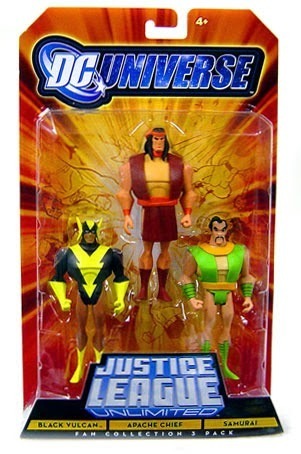
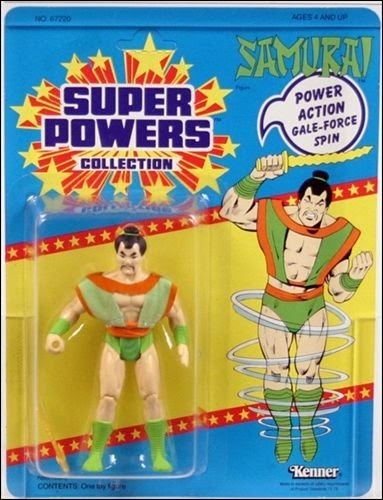
I bought two sets of the three figures—one for me (no shame) and one to divvy up and send to the men whose voices lent life to these characters: Buster Jones (Black Vulcan), Jack Angel (Samurai), and Michael Rye (Apache Chief).
The first two gamely gave me their addresses, but Michael was considerably older and in poor health so I didn’t want to trouble him.
Off went the Black Vulcan and Samurai figures (while their cartoon inspirations had the natural ability of flight, these versions flew via USPS).
But it was only recently that I went back to Buster and Black Vulcan and Jack and Samurai to ask for them to pose like this:


Obviously not only good actors but also good sports.
Huge thanks to my longtime friend Mike Fox for sparing Buster the awkward task of taking a selfie while holding a toy.
(Michael Rye died 9/21/12. RIP Apache Lantern.)
Around the same time, the first-ever figures of Black Vulcan and Apache Chief came out as part of the Justice League Unlimited line, packaged together with Samurai, who’d had a figure in the Super Powers line of the 1980s.


I bought two sets of the three figures—one for me (no shame) and one to divvy up and send to the men whose voices lent life to these characters: Buster Jones (Black Vulcan), Jack Angel (Samurai), and Michael Rye (Apache Chief).
The first two gamely gave me their addresses, but Michael was considerably older and in poor health so I didn’t want to trouble him.
Off went the Black Vulcan and Samurai figures (while their cartoon inspirations had the natural ability of flight, these versions flew via USPS).
But it was only recently that I went back to Buster and Black Vulcan and Jack and Samurai to ask for them to pose like this:


Obviously not only good actors but also good sports.
Huge thanks to my longtime friend Mike Fox for sparing Buster the awkward task of taking a selfie while holding a toy.
(Michael Rye died 9/21/12. RIP Apache Lantern.)
Published on May 18, 2014 04:00
May 16, 2014
Pakistani teacher got his tablet PC, but…
In March 2014, I put out a call to raise money to buy and send a tablet PC to a teacher in Pakistan who emailed me about the pathetic (his word) state of education there.
My network came through and then some, which means Tayyab gets his tablet and then some (namely a Bluetooth keyboard and a case).

In exchange for the computer shown above, Tayyab agreed to send me photos of himself and his students with said computer.
 Tayyab; three of his students are below
Tayyab; three of his students are below



Thank you again to the following for contributing (many of whom generously disregarded my request for donations of $5):
Lara N.
Rafael N.
Cristina P.
Michelle B.
Shira R.
Judy P.
Becca L.
Karen Y.
Bruce S.
Kristin C.
Mandee J.
Alison S.
Lauren D.
Paula Y.
Brad R.
Adam G.
Karen C.
Deborah M.
Candice G.
Anne K.
Elizabeth S.
Jennifer M.
Dara K.
Judy S.
David L.
Donna B.
Brett C.
But there is a “but.”
Though I sent the tablet on 3/25/14, customs held up delivery until 5/8/14.
And not without cost.
Tayyab had to pay 15,631 Pakistani rupees in duties and taxes...

...plus 7,391 in storage and civil aviation charges, none of which could have been calculated and paid for up front along with shipping.
In dollars, this totals more than $230—and therefore more than the cost of the tablet itself ($200 before tax, not to mention the $192 to FedEx it).
I asked Tayyab what his monthly salary is.
He said 20,000 Pakistani rupees—about $203.
He had to take out a loan just to receive this shipment, adding
So the tablet he asked me to send for his students ended up costing him more than if he had just bought it himself.
And I feel horribly.
So I’d like to work together again to reimburse Tayyab for these charges.
I’m asking the same as before: if you would like to help, please simply PayPal me $5; to do that, you don’t need a PayPal account yourself. All you need is approximately 27 seconds and my email, mtnobleman@gmail.com.
To pay off Tayyab’s debt, let’s make it an even $250. That’s only 50 people contributing only $5. (Of course, should you wish to give more, that will be gladly welcomed.)
Like the last round of fundraising, once we hit the goal, I’ll stop accepting donations.
Thank you for whatever you are willing to do.
And in any case, Tayyab and his students do have a device that he thinks will make a significant difference in his work, and their future.
My network came through and then some, which means Tayyab gets his tablet and then some (namely a Bluetooth keyboard and a case).

In exchange for the computer shown above, Tayyab agreed to send me photos of himself and his students with said computer.
 Tayyab; three of his students are below
Tayyab; three of his students are below


Thank you again to the following for contributing (many of whom generously disregarded my request for donations of $5):
Lara N.
Rafael N.
Cristina P.
Michelle B.
Shira R.
Judy P.
Becca L.
Karen Y.
Bruce S.
Kristin C.
Mandee J.
Alison S.
Lauren D.
Paula Y.
Brad R.
Adam G.
Karen C.
Deborah M.
Candice G.
Anne K.
Elizabeth S.
Jennifer M.
Dara K.
Judy S.
David L.
Donna B.
Brett C.
But there is a “but.”
Though I sent the tablet on 3/25/14, customs held up delivery until 5/8/14.
And not without cost.
Tayyab had to pay 15,631 Pakistani rupees in duties and taxes...

...plus 7,391 in storage and civil aviation charges, none of which could have been calculated and paid for up front along with shipping.
In dollars, this totals more than $230—and therefore more than the cost of the tablet itself ($200 before tax, not to mention the $192 to FedEx it).
I asked Tayyab what his monthly salary is.
He said 20,000 Pakistani rupees—about $203.
He had to take out a loan just to receive this shipment, adding
Marc I am the breadwinner for my family. I just requested you the Tablet PC so that it can facilitate ELT [English Language Teaching] over here. I am myself giving interviews for IELTS tutor but there are not much students in institutes so I do not get appropriate salary. I am still trying everyday as I really believe in POSITIVE THINKING! I know I just request you always of certain things but I see HOPE in your being.
So the tablet he asked me to send for his students ended up costing him more than if he had just bought it himself.
And I feel horribly.
So I’d like to work together again to reimburse Tayyab for these charges.
I’m asking the same as before: if you would like to help, please simply PayPal me $5; to do that, you don’t need a PayPal account yourself. All you need is approximately 27 seconds and my email, mtnobleman@gmail.com.
To pay off Tayyab’s debt, let’s make it an even $250. That’s only 50 people contributing only $5. (Of course, should you wish to give more, that will be gladly welcomed.)
Like the last round of fundraising, once we hit the goal, I’ll stop accepting donations.
Thank you for whatever you are willing to do.
And in any case, Tayyab and his students do have a device that he thinks will make a significant difference in his work, and their future.
Published on May 16, 2014 04:00
May 14, 2014
Bill Finger, Michael Uslan, and the inspiration for “Gotham”
The clever Michael Uslan(producer of every movie with Batman in it since 1989) had a brainstorm to hunt for a fun—and pivotal—piece of cultural history.
Bill Finger

Bill Finger

Published on May 14, 2014 04:00
Bill Finger, Michael Uslan, and the inspiration for "Gotham"
The clever Michael Uslan(producer of every movie with Batman in it since 1989) had a brainstorm to hunt for a fun—and pivotal—piece of cultural history.
Bill Finger

Bill Finger

Published on May 14, 2014 04:00
May 13, 2014
Nonfiction picture book narrative trajectory
I didn’t consciously notice this while writing it, but Bill the Boy Wonder: The Secret Co-Creator of Batman doesn’t follow a traditional nonfiction picture book story arc.
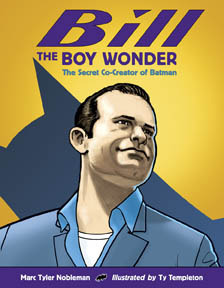
Conventionally it’s this:
young protagonist finds callingslightly older protagonist struggles to pursue callingadult protagonist ultimately succeeds
Bill the Boy Wonder rolls this way:
slightly older protagonist finds callingslightly older protagonist struggles to pursue callingolder protagonist succeeds on one level but dies poor, alone, and unheralded
Described that way, it sure sounds like a bummer of a story. But it has to be, because that is how it really happened. My job is to capture the truth as best as possible, even when that truth is sad. Even when the “hero” loses. For young people, there is, of course, value in that reading about that kind of life trajectory as well. (And there are some fun/inspirational moments throughout.)
Also unusually for a nonfiction picture book, Bill the Boy Wonder ends with the hope (and hint) that the story may not yet be over. I suppose this is what is meant by meta: in doing the book, the real-life “ending” may change.
I’m sure there are other exceptions to the traditional nonfiction picture book narrative arc, though none to come to mind. Do you know any?

Conventionally it’s this:
young protagonist finds callingslightly older protagonist struggles to pursue callingadult protagonist ultimately succeeds
Bill the Boy Wonder rolls this way:
slightly older protagonist finds callingslightly older protagonist struggles to pursue callingolder protagonist succeeds on one level but dies poor, alone, and unheralded
Described that way, it sure sounds like a bummer of a story. But it has to be, because that is how it really happened. My job is to capture the truth as best as possible, even when that truth is sad. Even when the “hero” loses. For young people, there is, of course, value in that reading about that kind of life trajectory as well. (And there are some fun/inspirational moments throughout.)
Also unusually for a nonfiction picture book, Bill the Boy Wonder ends with the hope (and hint) that the story may not yet be over. I suppose this is what is meant by meta: in doing the book, the real-life “ending” may change.
I’m sure there are other exceptions to the traditional nonfiction picture book narrative arc, though none to come to mind. Do you know any?
Published on May 13, 2014 04:00
May 12, 2014
Three-minute clip from "Batman at 75" panel at the Paley Center
On 5/5/14, I had the honor of joining Michael Uslan, Chip Kidd, Kevin Smith, and Kevin Conroy on a panel I also had the honor to name (and recap), “Batman at 75: To All a Dark Knight.”
The Paley does not post complete panels; here are the only three minutes you may get online:
The Paley does not post complete panels; here are the only three minutes you may get online:
Published on May 12, 2014 13:35



